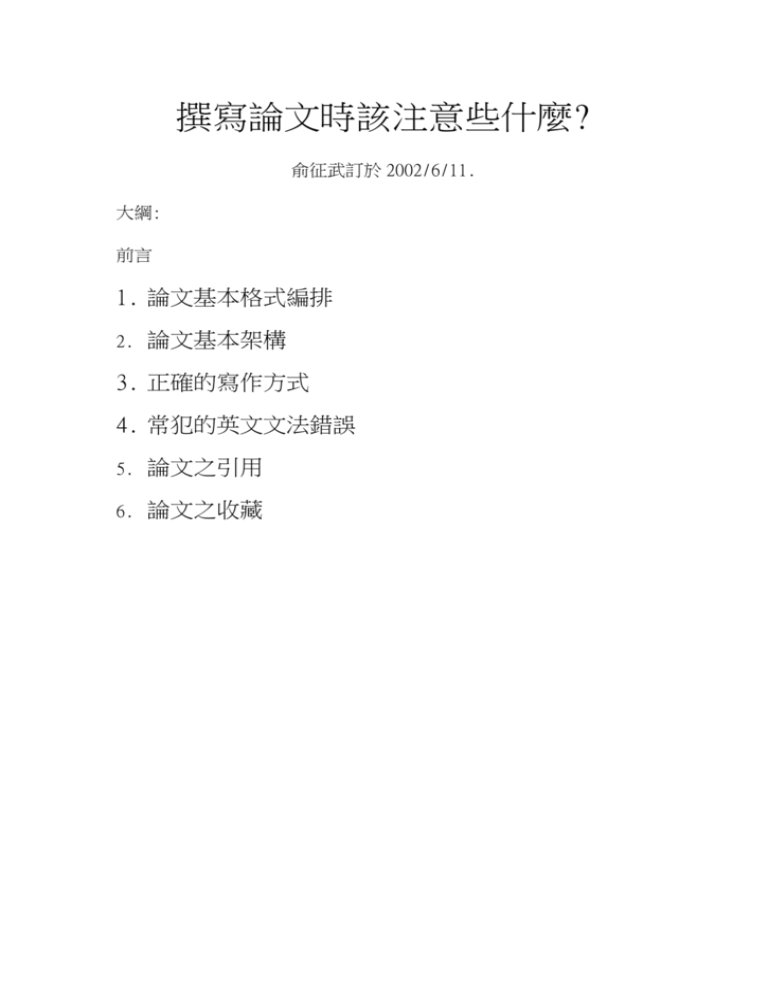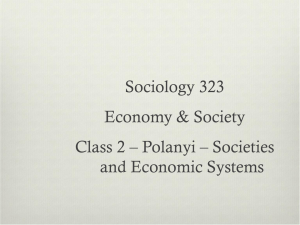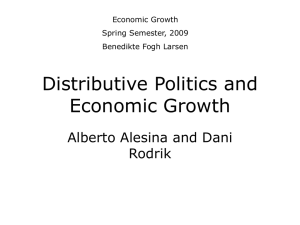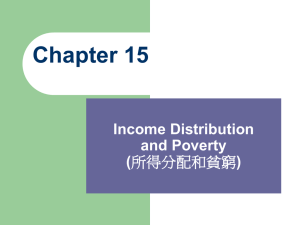撰寫論文時該注意些什麼? 俞征武訂於2002/6/11. 大綱: 前言 論文基本
advertisement

撰寫論文時該注意些什麼?
俞征武訂於 2002/6/11.
大綱:
前言
1. 論文基本格式編排
2.
論文基本架構
3. 正確的寫作方式
4. 常犯的英文文法錯誤
5.
論文之引用
6.
論文之收藏
零 前言
一般科技性質的學術論文有其一定的格式. 初寫論文的學生因較不熟悉,故
常有很大的困擾.所以寫了一些提示, 希望提醒自己或對我的學生有所幫助.
第一章 論文基本格式
寫作論文一般每個 Journal 有自己的規定. 但整篇論文必須有統一的格式
(format)卻是一致遵守的習慣.以下列出常見的規矩:
字體與字型:
1. Text 中 的 font 為 times new roman, 字體大小為 12 點字.
2. 每個 section 中的 title 其字體大小為 14( 小 section)或 16 點字(大
section).
3. Paper 的標題(title) 的字體大小為 18 點字, 而且需置中.
段落:
4. 文章中每段落左右需切齊.
5. 每一個 section 前需空一行.
6. 每一個 paragraph 前需縮排.
空格:
7. 逗號後面接一個空格, 如: … in the paper, hence ….
8. 在兩個 word 中只用一個空白分隔, 不可使用兩個空白以上.
斜體:
9. 論文中所有變數都要斜體, 如: When x>y, the algorithm ….
10.論文中自行定義的名詞在第一次出現時需斜體, 之後就不再用斜體.
11.論文中所有 constant 不要斜體, 如: When x1>y2, the algorithm …. 其中
1, 2 雖然在下標一樣不需斜體.
其他:
12.縮寫要用小括號, 如 random access memory (RAM).
13.使用三個小點(…)代表省略, 如 x1, x2, …, xn;
14.參考論文之引用需用中括號, 如: In [16], we have presented….
15.利用大括號代表集合(set), 如: Let S={1, 2, 3, 4, 5}, ….
16.整篇文章不用粗體(bold).
17.Figure 的說明在正下方, Tables 的說明在正上方.
18.定理證明結束的最後一行的最右方寫入“■”.
19.行間的距離請用 double space, 雖然不同的刊物有不同的要求.
第二章 論文基本架構
以下利用一個例子來說明論文的基本架構.
論文標題(title)
(論文標題範例)需簡短並指出論文的特色及貢獻
【範例】
Irregular Redistribution Scheduling by Partitioning
Messages
Chun-I Chen, Chang Wu Yu, Ching-Hsien Hsu, Kun-Ming Yu, and C.-K. Liang
Department of Computer Science and Information Engineering
Chung Hua University, Hsinchu, Taiwan 300, R.O.C.
{cwyu, chh, yu, ckliang}@chu.edu.tw
摘要(Abstract)
撰寫摘要可用一句話點明研究問題的領域及重要性。用兩三句話定義研究問
題及動機。再用兩三句話說明研究具體的成果,最後一句提及主要貢獻。
【範例】
Abstract
Dynamic data redistribution enhances data locality and improves algorithm
performance
for
numerous
scientific
problems
on
distributed
memory
multi-computers systems. Regular data distribution typically employs BLOCK,
CYCLIC, or BLOCK-CYCLIC(c) to specify array decomposition. Conversely, an
irregular distribution specifies an uneven array distribution based on user-defined
functions. Performing data redistribution consists of four costs: index computational
cost, schedule computational cost, message packing/unpacking cost, and data transfer
cost. Previous results focus on reducing the former three costs. However, in irregular
redistribution, messages with varying sizes are transmitted in the same
communication step. Therefore, the largest sized messages in the same
communication step dominate the data transfer time required for this communication
step. This work presents an efficient algorithm to partition large messages into
multiple small ones and schedules them by using the minimum number of steps
without communication contention and, in doing so, reducing the overall
redistribution time. When the number of processors or the maximum degree of the
redistribution graph increases or the selected size of messages is medium, the
proposed algorithm can significantly reduce the overall redistribution time to 52%.
Moreover, the proposed algorithm can be applied to arbitrary data redistribution while
slightly increasing the communication scheduling time.
Keywords: data redistribution, scheduling, edge coloring, bipartite graphs,
multi-graphs
1. 簡介(Introduction)
1.1 首先界定您的研究問題的研究領域並說明此領域在廣度上的重要性。
【範例】
Parallel computing systems have been extensively adopted to resolve
complex scientific problems efficiently. When processing various phases of
applications, parallel systems normally exploit data distribution schemes to
balance the system load and yield a better performance. Generally, data
distributions are either regular or irregular. Regular data distribution typically
employs
BLOCK,
CYCLIC,
or
BLOCK-CYCLIC(c)
to
specify
array
decomposition [14, 15]. Conversely, an irregular distribution specifies an
unevenly array distribution based on user-defined functions. For instance, High
Performance Fortran version 2 (HPF2) provides a generalized block distribution
(GEN_BLOCK) [19, 20] format, allowing unequally sized messages (or data
segments) of an array to be mapped onto processors. GEN_BLOCK paves the
way for processors with varying computational abilities to handle appropriately
sized data.
Array redistribution is crucial for system performance because a specific array
distribution may be appropriate for the current phase, but incompatible for the
subsequent one. Many parallel programming languages thus support run-time
primitives for rearranging a program’s array distribution. Therefore developing
efficient algorithms for array redistribution is essential for designing distributed
memory compilers for those languages. While array redistribution is performed at run
time, a trade-off occurs between the efficiency of the new data rearrangement for the
coming phase and the cost of array redistributing among processors.
1.2 在此研究領域上有何研究問題需要解決? 可和先人的成果比較以突顯本論
文的創意。
【範例】
Performing data redistribution consists of four costs: index computational cost Ti,
schedule computational cost Ts, message packing/unpacking cost Tp and data transfer
cost. The index and schedule computations are executed in complier time, with the
remaining in run time. The data transfer cost for each communication step consists of
start-up cost Tu and transmission cost Tt. Let the unit transmission time denote the
cost of transferring a message of unit length. The total number of communication
i c
steps is denoted by C. Total redistribution time equals Ti+Ts+ (T p Tu mi ) ,
i 1
where mi =Max{d1, d2, d3, .., dk} and dj represents the size of message scheduled in ith
communication step for j=1 to k.
Previous results focus on reducing the former three costs (i.e., Ti, Ts, and Tu). In
irregular redistribution, messages of varying sizes are scheduled in the same
communication step. Therefore, the largest size of message in the same
communication step dominates the data transfer time required for this communication
step.
1.3 此問題期望如何被解決:如降低演算法的時間複雜度或減少電源的耗費等盡
可能利用量化說明。
【範例】
Based on the fact, this work presents an efficient algorithm to partition large
messages into multiple small ones and schedules them by using the minimum number
of steps without communication contention and, in doing so, reducing the overall
redistribution time.
1.4. 說明研究動機:如果此問題沒被解決或是充分瞭解,會有多大的負面的問題?
明確地直接地說明本研究的目標。
1.6.您的研究將利用何種技巧達成預期的成果。
【範例】
Specifically, the minimum value of Ts, and C are derived, along with the value of
mi reduced by shortening the required communication time for each communication
step.
1.7.說明預期的結果。
1.8 預期此研究對整個領域的貢獻?(廣度)
【範例】
When the number of processors or the maximum degree of the redistribution
graph increases or the selected size of messages is medium, the proposed algorithm
can significantly reduces the overall redistribution time to 52%. Moreover, the
proposed algorithm can be applied to arbitrary data redistribution while slightly
increasing the communication scheduling time.
緊接著是整篇論文的大綱:
【範例】
The rest of the paper is organized as follows. Section 2 presents necessary
definitions and notations. Next, Section 3 describes the basic graph model along with
related work. The main contribution of the paper is shown in Section 4. We also
conduct simulations in Section 5 to demonstrate the merits of our algorithm. Finally,
Section 6 concludes the paper.
2. 前人成果介紹(survey)
【範例一】
AODV (Ad Hoc On-Demand Distance-Vector) [16, 18] Routing is an
improvement to the table-driven and distance-vector based DSDV algorithm. With
DSDV (Destination-Sequenced Distance-Vector) Routing [17], every mobile node
maintains a routing table recording all the possible destinations and number of hops to
each destination. In order to maintain routing table consistency, it requires nodes to
periodically broadcast routing updates throughout the network.
【範例二】
Techniques for regular array redistribution can be classified into two groups: the
communication sets identification and communication optimizations. The former
includes the PITFALLS [17] and the ScaLAPACK [16] methods for index sets
generation. Park et al. [14] devised algorithms for BLOCK-CYCLIC data
redistribution between processor sets. Dongarra et al. [15] proposed algorithmic
redistribution methods for BLOCK-CYCLIC decompositions. Zapata et al. [1]
designed parallel sparse redistribution code for BLOCK-CYCLIC data redistribution
based on CRS structure. Also, the Generalized Basic-Cycle Calculation method was
presented in [3]. Techniques for communication optimizations provide different
approaches to reduce the communication overheads in a redistribution operation.
3. 定義或背景(notations and definitions)
【範例】
Any data redistribution can be represented by a bipartite graph G=(S, T, E),
called a redistribution graph. Where S denotes source processor set, T denotes
destination processor set, and each edge denotes a message required to be sent. For
example, a Block-Cyclic(x) to Block-Cyclic(y) data redistribution from P processors
to Q processors (denoted by BC (x, y, P, Q)) can be modeled by a bipartite graph
GBC(x, y, P, Q)=(S, T, E) where S={s0, s1, …, ss-1} (T={t0, t1, …, tt-1}) denotes the source
processor set {p0, p1, …, ps-1} (destination processor set{p0, p1, …, pt-1}) and we
have (si, tj)E with weight w if source processor pi has to send the amount of w data
elements to destination processor pj. For simplicity, we use BC (x, y, P) to denote BC
(x, y, P, P).
4. 主要成果(main results)
4.1 Motivation
【範例】
Given a redistribution graph G with its edge coloring, the edges colored the same
is a matching of G; thus represents a set of conflict-free data communication.
Accordingly, for a given data redistribution problem, a conflict-free scheduling with
the minimum number of communication steps can be obtained by coloring the edges
of the corresponding redistribution graph G. When G is bipartite, it is well known that
(G)=(G) [22]. As a result, the minimum number of required communication steps
equals the maximum degree of the given distribution graph G.
Previous work is equivalent to finding out an edge colorings {E1, E2, E3, …, E}
of G so that
i 1
max wk ek Ei where wk is the weight of ek (i.e., the data transfer
time) can be decreased. To the best of our knowledge, it is still open to devise an
efficient algorithm to minimize both of the overall redistribution time and
communication steps.
Unlike existing algorithms, the main idea behind our work is to partition large
data segments into multiple small data segments and properly schedule them in
different communication steps without increasing the number of total communication
steps.
4.2 An example
【範例】
For example, Figure 6 depicts a redistribution graph with the maximum degree
=4.
Figure 6. A redistribution graph with =4.
We need four communication steps for this data redistribution since
(G)=(G)=4. In addition, the overall cost of the corresponding scheduling is 38 (See
Table 1).
Table 1. The scheduling corresponds to the edge coloring in Figure 4.
Step
1(red)
2(yellow)
3(green)
4(purple)
Total
Cost
18
6
3
11
38
Note that the time cost of Step 1 (colored in red) is dominated by the data
segment (with 18 data elements) from P0 to Q0. Suppose that we evenly partition the
segment into two data segments (with 9 and 9 data elements respectively) and
transmit them in different steps; then the time required for Step 1 is reduced to 10
(dominated by the data segment from P3 to Q3). Note that the data partition adds an
edge (P0, Q0) in the original redistribution graph. Similarly, we can partition any large
data segment into multiple small data segment if the maximum degree of the resulting
redistribution graph remains unchanging. After several data partitions, the overall
communication cost can be reduced to 29 and the number of required communication
step is still minimized (see Figure 7 and Table 2).
Figure 7. The resulting redistribution graph after partitioning long data segments.
Table 2. The scheduling after partition long data communications.
Step
1(red)
2(yellow)
3(green)
4(purple)
Total
Cost
9
9
5
6
29
較正式的成果說明。
【範例】
The algorithm of the selection step is shown as follows.
Algorithm Selection()
Input: A redistribution graph G=(S, T, E) with maximum degree ∆.
Output: A redistribution graph G=(S, T, ED) with maximum degree ∆, where D
represents those dummy edges added in the algorithm.
Step 1. Select the edge ek=(si, tj) from E such that the value wk/(1+vk) is the largest and
dG(si)<∆ and dG(tj)<∆, where vk denotes the number of added dummy edge with the
same end points of ek. If no such edge exists, terminate this algorithm.
Step 2. Add a dummy edge ek’=(si, tj) to D and set vk=vk+1.
Step 3. Go to Step 1.
The time complexity of Selection is O(mlog m), where m is the size of edge set
of the input redistribution graph.
4.4 Complexity
5. 理論上的證明(simulation results)
6. 實驗或模擬結果(simulation results)
【範例】
Our simulations were conducted in C for GEN_BLOCK distribution. Given an
irregular array redistribution on A[1:N] over P processors, the average size of data
blocks is N/P. Let Tb(Ta) denote the total redistribution cost without (with) applying our
algorithm. The reduction ratio R equals (Tb-Ta)/Tb. Moreover, let {E1, E2, E3, …, E}
of
G
denote
the
output
of
Scheduling
step.
We
also
define
Ci
= max wk ek (u, v) Ei and either d (u) or d (v) , where wk is the weight of ek .
i
As a result, the overall redistribution time is bounded by B= C i since the proposed
i 1
algorithm does not select maximum-degree edges for further partition. Otherwise, the
required communication step will be increased.
To thoroughly evaluate how our algorithm affects the data transfer cost, our
simulations consider different scenarios. Each data point in the following figures
represents an average of at least 10000 runs in each different scenario.
The first scenario assumes that the size of data array is fixed, i.e., N=100; the
number of processors range from 4, 8, 16, 32, 64, to 128; the size of data blocks is
randomly selected between 1 and 50. In Figure 12, the value of Tb drastically raises as
the number of processors increases. However, after applying our algorithm, the overall
distribution time Ta smoothly raises as the number of processors increases. Note that the
B value drops as the number of processor increase due to the decrease of the average
values of data elements in a single communication. In short, when the number of
processors increases, the reduction ratio R raises if applying our partition algorithm.
Figure 12. Simulation results of Scenario I.
The second scenario assumes that the number of processors is fixed, i.e., P=32;
the size of data array N equals 1600, 3200, 6400, 9600, or 12800; and the size of data
blocks is randomly selected between 1 and 2(N/P). As shown in Figure 13, the
values of Ta, Tb, and B raises as the size of data array N increases due to the increase of
the average number of data elements in a single communication. However, the
reduction ratio stays about 52% by applying our partition algorithm, even with the
large size of data array.
Figure 13. Simulation results of Scenario II.
7. 結論(conclusion)
結論是整篇論文的收官。若能餘音饒樑則必成佳作。
簡單摘要整篇論文的貢獻及使用的技巧
此研究對該領域有何啟發?
貢獻有何處可擴展
1. Were your results expected? If not, why not?
2. What generalizations or claims are you making about your results?
3. Do your results contradict or support other experimental results?
4. Do they suggest other observations or experiments which could be done to
confirm, refute, or extend your results?
5. Do your results support or contradict existing theory?
6. Do your results suggest that modifications or extensions need to be made
to existing theory? What are they?
7. Could your results lead to any practical applications?
Stress how the results in this study confirm your engineering/Scientific
motivations (specific and general) and, ultimately, your reader's interests(i.e.
Engineering/Scientific need).
【範例】
We have presented an efficient algorithm to reduce the overall redistribution time
by applying data partition. Simulation results indicates that when the number of
processors or the maximum degree of the redistribution graph increases or the
selected size of data blocks is appropriate, our algorithm effectively reduce the overall
redistribution time. In future, we try to estimate the reduction ratio precisely. We also
believe that the techniques developed in the study can be applied to resolve other
scheduling problems in distribution systems.
參考文獻(References)
【範例】
References:
[1]
[2]
[3]
G. Bandera and E.L. Zapata, “Sparse Matrix Block-Cyclic Redistribution,”
Proceeding of IEEE Int'l. Parallel Processing Symposium (IPPS'99), San Juan,
Puerto Rico, April 1999.
Frederic Desprez, Jack Dongarra and Antoine Petitet, “Scheduling Block-Cyclic
Data redistribution,” IEEE Trans. on PDS, vol. 9, no. 2, pp. 192-205, Feb. 1998.
C.-H Hsu, S.-W Bai, Y.-C Chung and C.-S Yang, “A Generalized Basic-Cycle Calculation Method for Efficient Array
Redistribution,” IEEE
[4]
[5]
[6]
[7]
[8]
[9]
[10]
TPDS, vol. 11, no. 12, pp. 1201-1216, Dec. 2000.
C.-H Hsu, Dong-Lin Yang, Yeh-Ching Chung and Chyi-Ren Dow, “A
Generalized Processor Mapping Technique for Array Redistribution,” IEEE
Transactions on Parallel and Distributed Systems, vol. 12, vol. 7, pp. 743-757,
July 2001.
Minyi Guo, “Communication Generation for Irregular Codes,” The Journal of
Supercomputing, vol. 25, no. 3, pp. 199-214, 2003.
Minyi Guo and I. Nakata, “A Framework for Efficient Array Redistribution on
Distributed Memory Multicomputers,” The Journal of Supercomputing, vol. 20,
no. 3, pp. 243-265, 2001.
Minyi Guo, I. Nakata and Y. Yamashita, “Contention-Free Communication
Scheduling for Array Redistribution,” Parallel Computing, vol. 26, no.8, pp.
1325-1343, 2000.
Minyi Guo, I. Nakata and Y. Yamashita, “An Efficient Data Distribution
Technique for Distributed Memory Parallel Computers,” JSPP'97, pp.189-196,
1997.
Minyi Guo, Yi Pan and Zhen Liu, “Symbolic Communication Set Generation for
Irregular Parallel Applications,” The Journal of Supercomputing, vol. 25, pp.
199-214, 2003.
Edgar T. Kalns, and Lionel M. Ni, “Processor Mapping Technique Toward
Efficient Data Redistribution,” IEEE Trans. on PDS, vol. 6, no. 12, December
1995.
第三章 正確的寫作方式
論文寫作著實不易,市面上也有相當多著作。我個人認為:如何將您的研究成
果, 用最容易被接受的方式準確地表示出來, 就是論文寫作的目的之一。
3.1 突顯您的貢獻的重要程度
1. 背景(background)說明須完整,尤其是前人的弱點。
2. 突顯動機(motivation)常可用來突顯論文的重要。
3.
表達需準確簡潔
4.
一篇好文章一般需要以下特色:
甲、創意
乙、貢獻
丙、分析
丁、仔細地實驗或嚴謹的證明
3.2 表達的邏輯需連貫一致
上一個句子和下一個句子之間,邏輯上必須因果相互連貫的。 寫一句文章
後, 必須確認是否已經充分將您的概念表達出來了. 寫一段文章後, 必須重新改
寫得使隻更簡潔有力.
3.3 可讀性
1. 寫一句文章後, 必須確認是否讀者可以輕鬆地就可了解.
2. 勿用太多符號干擾讀者.
3. 多利用圖解及實例。
3.4 閱讀自己的文章
先說明你的創見的直覺概念
再用例子解釋 ideas
最後用 algorithm 來準確描述方法.
於適當時機提出證明或實驗
第四章 常犯的英文文法錯誤
您可能常犯的英文文法錯誤羅列如下:
1. even, therefore, then, 是 adverb, 不是 conjunction.
第五章 論文之引用
在本章中我們介紹 IEEE 對引用論文時的規定
1. 排列順序要按照 Last name 的順序來排.
2. Journal, Conference, 書的名稱需斜體
引用專書時之寫法如下:
1. T. Cover and J. Thomas, Elements of Information Theory. New York: Wiley,
1991.
引用 Journal 之寫法如下:
1. Michael Luby, “A simple parallel algorithm for the maximal
independent set Problem,” SIAM Journal on Computing, vol.15, pp.
1036-1053, 1986.
引用 Conference 之寫法如下:
1. L. Hu, “Distributed code assignments for CDMA packet radio networks,
“ in Proc. INFOCOM, 1991, pp. 1500-1509.
引用網址之寫法如下:
第六章 論文之收藏
請將下列電子檔分不同目錄燒成一份光碟給我.
1. 論文(請用英文撰寫)
2. 投稿會議論文(請用英文撰寫)
3.
4.
5.
6.
口試投影片(請用英文撰寫)
實驗程式碼需加註解
實驗數據及圖檔 (需用 mathlab 劃圖)
論文前人相關文獻.
參考書目:
1. 柯泰德線上英文論文編修網站 http://owl.cmgt.nctu.edu.tw/







